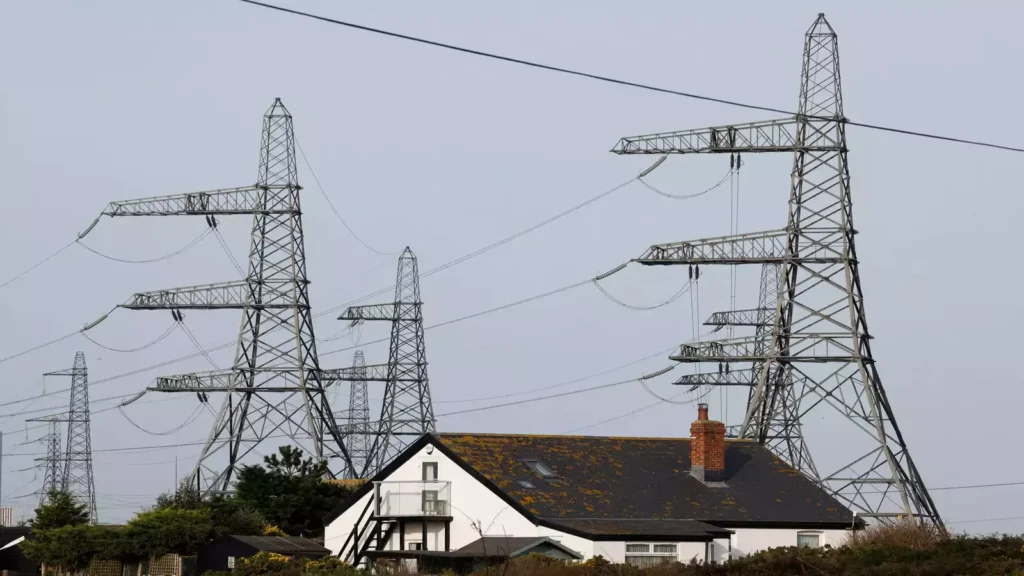The UK government has unveiled a new plan to offer financial incentives to households located near new or upgraded electricity pylons. Under this scheme, residents within 500 meters of these structures will receive discounts on their energy bills, amounting to up to £250 annually for a decade, totaling £2,500 per household. While the initiative is designed to accelerate the development of the UK’s clean energy infrastructure, it has sparked controversy as energy customers nationwide will bear the cost through slight increases in their bills.
A Push for Infrastructure and Renewable Energy
The compensation plan is part of the upcoming Planning and Infrastructure Bill, a legislative move aimed at expediting the approval and construction of essential energy projects. The UK government is targeting a net-zero power sector by 2030, necessitating significant investments in energy transmission infrastructure.
To support this expansion, a Community Benefits Fund will be established, financing local projects such as sports facilities and youth centers in areas affected by new pylons. The initiative intends to offset concerns about visual and environmental impacts while ensuring that communities directly affected by infrastructure projects receive tangible benefits.
Government officials argue that expanding the electricity grid is crucial for integrating more renewable energy sources, such as wind and solar power, into the national supply. The UK aims to reduce dependency on fossil fuels and meet its climate commitments, making it imperative to upgrade and extend transmission lines.
For more information on the government’s energy transition strategy, visit the official UK government page: gov.uk.
How the Compensation Scheme Works?

Households situated within 500 meters of newly constructed or upgraded pylons will receive an automatic energy bill discount. This discount will apply over a 10-year period, easing financial burdens for those most affected by the presence of these structures.
However, to finance this initiative, a small surcharge will be added to energy bills across the country. The government estimates that the additional cost for UK households will be approximately 80 pence per year—a figure that critics argue could increase over time.
According to a statement from the Department for Energy Security and Net Zero, the policy balances national infrastructure development with local interests. “Expanding the grid is crucial for ensuring an affordable and sustainable energy future. By offering direct financial support to those most impacted, we can accelerate these critical projects,” a spokesperson said.
For details on the UK’s energy policies, visit: Department for Energy Security and Net Zero.
Concerns Over Property Value and Community Impact
Despite the government’s efforts to mitigate the impact of pylons, many residents fear that the presence of these structures will negatively affect property values.
For example, Bill Doran, a homeowner in Roxwell, Essex, expressed concern over the potential devaluation of his property due to a 55-meter pylon planned near his residence. He estimates that his home could lose up to £200,000 in value, far exceeding the £2,500 compensation package over ten years.
“These pylons are an eyesore, and they will make it much harder to sell our homes in the future. The compensation is nowhere near enough to cover the losses we could face,” Doran told The Times (source).
Concerns like Doran’s are echoed by other communities affected by new transmission projects. While the financial compensation may ease short-term costs, long-term worries about property depreciation, landscape disruption, and potential health impacts continue to fuel opposition.
The Bigger Picture: Balancing Progress with Public Opinion
The UK’s transition to a cleaner energy grid requires extensive infrastructure investment, but achieving this balance remains a challenge. The government hopes that by offering financial incentives and community benefits, local opposition will soften, paving the way for faster project approvals and construction.
Similar policies have been implemented in Scotland, where energy firms provided direct payments to residents living near power lines. However, studies have shown that initial fears over dramatic property devaluation did not always materialize to the extent expected (source).
Public Response and Next Steps

The controversy surrounding the scheme highlights broader tensions in the UK’s energy transition. While some see it as a necessary step toward a greener future, others feel that the government is asking ordinary households to foot the bill for a project that benefits the national grid rather than individuals.
A public consultation is expected to take place before the bill is finalized. Advocacy groups and energy customers can provide feedback on the policy, with some calling for greater transparency on how surcharge funds will be managed. Consumer rights groups have also urged the government to explore alternative funding mechanisms to avoid burdening households already struggling with high energy costs.
For updates on the public consultation process, visit: UK Parliament Bills.
Conclusion
The UK’s plan to compensate households near new pylons aims to address local concerns while pushing forward a much-needed infrastructure expansion. However, the scheme has sparked debate over fairness, cost distribution, and long-term property impacts. With public opinion divided, the next few months will be crucial in determining whether the government can successfully implement this policy while maintaining support from affected communities.
What do you think about this initiative? Should all UK residents contribute to compensating affected households, or should alternative funding be explored? Let us know in the comments.

Vikas is a seasoned finance writer with a keen eye for unraveling complex global financial systems. From government benefits to energy rebates and recruitment trends, he empowers readers with actionable insights and clarity. When he’s not crafting impactful articles, you can find him sharing her expertise on Social Media. You can connect with him via email at [email protected].









